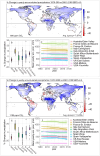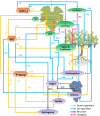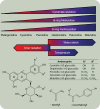Toward understanding grapevine responses to climate change: a multi-stress and holistic approach
- PMID: 39589787
- PMCID: PMC12321744
- DOI: 10.1093/jxb/erae482
Toward understanding grapevine responses to climate change: a multi-stress and holistic approach
Abstract
Recent research has extensively covered the effects of climate change factors, such as elevated CO2, rising temperatures, and water deficit on grapevine (Vitis spp.) biology. However, assessing the impacts of multiple climate change-related stresses on this crop remains complex due to interactive effects among environmental factors, and the regulatory mechanisms that underlie these. Consequently, there is a substantial discrepancy between the number of studies conducted with a single factor or two factors simultaneously, and those with a more holistic approach. Changes in crop phenology in response to temperature have been a major focus of many studies. We highlight how the impact of rising temperatures will be enhanced during specific developmental periods, such as grape ripening. However, how these shifts may result in deleterious effects on yield and quality deserves further research. Rising temperatures will most certainly continue to represent a substantial threat to viticulture due to its effects on grape phenology, composition, and crop water requirements. Nevertheless, elevated CO2 may offer some relief through increased water use efficiency, as shown in recent studies. Hormones play a major role within the repertoire of regulatory mechanisms that plants possess, with crosstalk between hormones explaining the effects of combined stresses. In fact, growth regulators can fine-tune stress responses depending on the multiple stresses present. This review focuses on the interaction of climate change factors across viticultural areas of the globe, and how multi-stress responses are mediated by abscisic acid and jasmonate, with emphasis on the intricate interconnections of signalling among different plant hormones.
Keywords: Elevated CO2; hormone signalling; interaction; multi-stress; temperature; viticulture; water deficit.
© The Author(s) 2024. Published by Oxford University Press on behalf of the Society for Experimental Biology.
Conflict of interest statement
Conflict of interest: The authors have no conflicts to declare
Figures






Similar articles
-
Short-Term Memory Impairment.2024 Jun 8. In: StatPearls [Internet]. Treasure Island (FL): StatPearls Publishing; 2025 Jan–. 2024 Jun 8. In: StatPearls [Internet]. Treasure Island (FL): StatPearls Publishing; 2025 Jan–. PMID: 31424720 Free Books & Documents.
-
Management of urinary stones by experts in stone disease (ESD 2025).Arch Ital Urol Androl. 2025 Jun 30;97(2):14085. doi: 10.4081/aiua.2025.14085. Epub 2025 Jun 30. Arch Ital Urol Androl. 2025. PMID: 40583613 Review.
-
The Black Book of Psychotropic Dosing and Monitoring.Psychopharmacol Bull. 2024 Jul 8;54(3):8-59. Psychopharmacol Bull. 2024. PMID: 38993656 Free PMC article. Review.
-
The Lived Experience of Autistic Adults in Employment: A Systematic Search and Synthesis.Autism Adulthood. 2024 Dec 2;6(4):495-509. doi: 10.1089/aut.2022.0114. eCollection 2024 Dec. Autism Adulthood. 2024. PMID: 40018061 Review.
-
Temperature sensitivity of the interspecific interaction strength of coastal marine fish communities.Elife. 2023 Jul 11;12:RP85795. doi: 10.7554/eLife.85795. Elife. 2023. PMID: 37431235 Free PMC article.
References
-
- Ainsworth EA, Rogers A. 2007. The response of photosynthesis and stomatal conductance to rising [CO2]: mechanisms and environmental interactions. Plant Cell & Environment 30, 258–270. - PubMed
-
- Arias P, Bellouin N, Coppola E, Jones R, Krinner G, Marotzke J, Naik V, Palmer M, Plattner G-K, Rogelj J. 2021. Climate change 2021: the physical science basis. In: Contribution of Working Group I to the Sixth Assessment Report of the Intergovernmental Panel on Climate Change; technical summary. https://www.ipcc.ch/report/ar6/wg1/downloads/report/IPCC_AR6_WGI_Summary....
-
- Arrizabalaga M, Morales F, Oyarzun M, Delrot S, Gomès E, Irigoyen JJ, Hilbert G, Pascual I. 2018. Tempranillo clones differ in the response of berry sugar and anthocyanin accumulation to elevated temperature. Plant Science 267, 74–83. - PubMed
Publication types
MeSH terms
Substances
Grants and funding
LinkOut - more resources
Full Text Sources
Medical
Miscellaneous

